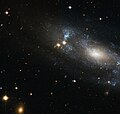Dosya:A loose spiral galaxy.jpg

Tam çözünürlük ((3.949 × 3.741 piksel, dosya boyutu: 11,82 MB, MIME tipi: image/jpeg))
Bu dosya Wikimedia Commons'ta bulunmaktadır. Dosyanın açıklaması aşağıda gösterilmiştir. Commons, serbest/özgür telifli medya dosyalarının bulundurulduğu depodur. Siz de yardım edebilirsiniz. |
Özet
| AçıklamaA loose spiral galaxy.jpg |
English: The NASA/ESA Hubble Space Telescope has spotted the spiral galaxy ESO 499-G37, seen here against a backdrop of distant galaxies, scattered with nearby stars.
The galaxy is viewed from an angle, allowing Hubble to reveal its spiral nature clearly. The faint, loose spiral arms can be distinguished as bluish features swirling around the galaxy’s nucleus. This blue tinge emanates from the hot, young stars located in the spiral arms. The arms of a spiral galaxy have large amounts of gas and dust, and are often areas where new stars are constantly forming. The galaxy’s most characteristic feature is a bright elongated nucleus. The bulging central core usually contains the highest density of stars in the galaxy, where typically a large group of comparatively cool old stars are packed in this compact, spheroidal region. One feature common to many spiral galaxies is the presence of a bar running across the centre of the galaxy. These bars are thought to act as a mechanism that channels gas from the spiral arms to the centre, enhancing the star formation. Recent studies suggest that ESO 499-G37’s nucleus sits within a small bar up to a few hundreds of light-years along, about a tenth the size of a typical galactic bar. Astronomers think that such small bars could be important in the formation of galactic bulges since they might provide a mechanism for bringing material from the outer regions down to the inner ones. However, the connection between bars and bulge formation is still not clear since bars are not a universal feature in spiral galaxies. Lying in the constellation of Indus, ESO 499-G37 is located about 59 million light-years away from the Sun. The galaxy, which belongs to the NGC 3175 group, lies in the southern constellation of Antlia (The Air Pump). This picture was created from visible and infrared exposures taken with the Wide Field Channel of the Advanced Camera for Surveys. The field of view is approximately 3.4 arcminutes wide. |
| Tarih | |
| Kaynak | http://www.spacetelescope.org/images/potw1247a/ |
| Yazar | ESA/Hubble & NASA |
Lisanslama
- Şu seçeneklerde özgürsünüz:
- paylaşım – eser paylaşımı, dağıtımı ve iletimi
- içeriği değiştirip uyarlama – eser adaptasyonu
- Aşağıdaki koşullar geçerli olacaktır:
- atıf – Esere yazar veya lisans sahibi tarafından belirtilen (ancak sizi ya da eseri kullanımınızı desteklediklerini ileri sürmeyecek bir) şekilde atıfta bulunmalısınız.
Altyazılar
Bu dosyada gösterilen öğeler
betimlenen
Vikiveri ögesi olmayan bir değer
19 Kasım 2012
image/jpeg
92231c2565e8a359c42330356d4955dc5a9f5ad5
12.392.266 Bayt
3.741 piksel
3.949 piksel
Dosya geçmişi
Dosyanın herhangi bir zamandaki hâli için ilgili tarih/saat kısmına tıklayın.
| Tarih/Saat | Küçük resim | Boyutlar | Kullanıcı | Yorum | |
|---|---|---|---|---|---|
| güncel | 13.33, 19 Kasım 2012 |  | 3.949 × 3.741 (11,82 MB) | Jmencisom | User created page with UploadWizard |
Dosya kullanımı
Bu görüntü dosyasına bağlantısı olan sayfalar:
Küresel dosya kullanımı
Aşağıdaki diğer vikiler bu dosyayı kullanır:
- ca.wikipedia.org üzerinde kullanımı
- de.wikipedia.org üzerinde kullanımı
- ko.wikipedia.org üzerinde kullanımı
- mk.wikipedia.org üzerinde kullanımı
Meta veri
Bu dosyada, muhtemelen fotoğraf makinesi ya da tarayıcı tarafından eklenmiş ek bilgiler mevcuttur. Eğer dosyada sonradan değişiklik yapıldıysa, bazı bilgiler yeni değişikliğe göre eski kalmış olabilir.
| Çevrimiçi telif hakkı bildirimi | |
|---|---|
| Katkı/Sağlayıcı | ESA/Hubble & NASA |
| Kaynak | ESA/Hubble |
| Kullanım şartları |
|
| Kısa başlık |
|
| Resim başlığı |
|
| Verinin ilk yaratılma zamanı | 10.00, 19 Kasım 2012 |
| Telif hakkı durumu | Telif hakkı durumu belirtilmemiş |
| Anahtar kelimeler | ESO 499-G37 |
| İletişim bilgileri |
http://www.spacetelescope.org/ Karl-Schwarzschild-Strasse 2 Garching bei München, , D-85748 Germany |
